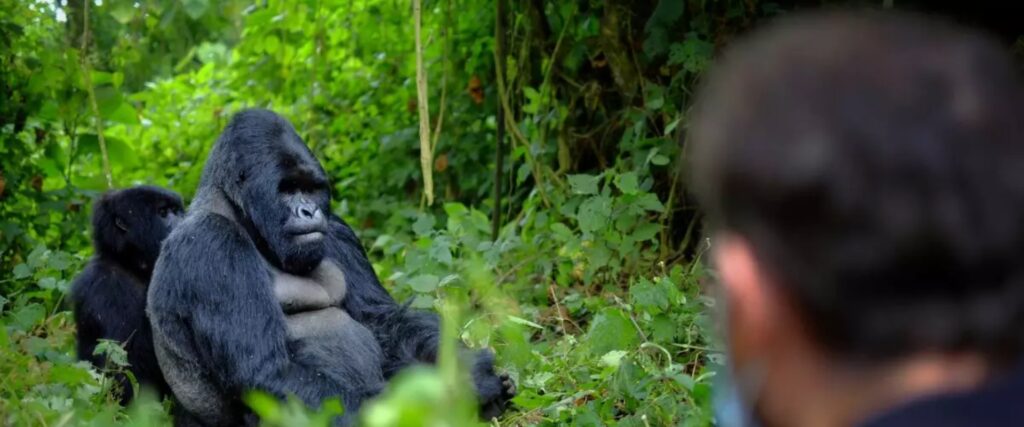Gorilla trekking in Uganda and Rwanda offers a rare and intimate opportunity to observe these magnificent creatures in their natural habitat. While the experience is undoubtedly thrilling, it comes with a significant responsibility – to respect the gorillas and their environment. In this article, we will explore the essential gorilla trekking etiquette that not only ensures your safety but also safeguards the well-being of these endangered animals.

Understanding East African Gorilla Habitat
Before delving into etiquette, it’s crucial to comprehend what constitutes a gorilla habitat. Gorillas inhabit dense tropical forests, and their habitat is a delicate ecosystem that supports various flora and fauna. These habitats are characterized by the following elements:
- Lush Vegetation: Gorilla habitats are rich in lush vegetation, including dense undergrowth and towering trees. The vegetation provides food, shelter, and a sense of security for gorillas.
- Variety of Plants: These habitats are home to a variety of plant species, which are an essential part of a gorilla’s diet. Gorillas are primarily herbivores, feeding on leaves, stems, fruits, and other plant material.
- Water Sources: Gorillas require access to freshwater, so their habitats often include streams, rivers, and small ponds where they can drink and cool off.
- Biodiversity: Gorilla habitats are teeming with biodiversity. In addition to gorillas, you may encounter other wildlife species, such as birds, primates, and smaller mammals.
- Remote and Inaccessible: Gorilla habitats are usually remote and challenging to access, which has helped protect these creatures from human disturbances to some extent.
Now that we have a basic understanding of a gorilla’s habitat, let’s explore the etiquette that ensures the preservation of both the gorillas and their environment:
Kawira Safaris Recommended Gorilla Trekking Etiquette
- Observe from a Safe Distance
Maintain a respectful and safe distance from the gorillas at all times. The recommended minimum distance is usually about 7 meters (21 feet), although it can vary slightly depending on the park’s regulations. Staying at a distance minimizes the risk of disease transmission and reduces stress on the gorillas.
- Silence and Minimal Noise
During your trek, maintain a low volume and minimize noise. Gorillas are sensitive to loud sounds, which can agitate them. Whisper when you communicate with fellow trekkers and guides to maintain a peaceful environment.
- No Flash Photography
Flash photography is strictly prohibited when photographing gorillas. The sudden burst of light can startle them and cause distress. Use your camera’s natural light settings and capture the gorillas without disturbing them.
- Stay in a Group
Follow your trekking group and guides closely. Straying from the group can be disorienting for gorillas and increase the risk of negative interactions. Additionally, guides are trained to interpret gorilla behavior and will help ensure a safe encounter.
- Do Not Touch the Gorillas
Under no circumstances should you attempt to touch the gorillas. This is to protect both you and the gorillas from potential disease transmission. Keep a respectful distance and let them go about their daily activities undisturbed.
- Follow Leave No Trace Principles
Leave no trace of your presence in the gorilla habitat. Properly dispose of trash and adhere to park rules regarding waste disposal. Avoid picking plants, littering, or disturbing the natural environment.
- Respect Park Regulations
Each gorilla trekking park may have specific regulations, such as the maximum duration of visits, the number of visitors per gorilla group, and specific trekking paths. Always follow these regulations to minimize your impact on the habitat.
- Health Precautions
Before embarking on a gorilla trek, ensure you are in good health to prevent the spread of diseases to the gorillas. If you have any symptoms of illness, it’s best to postpone your trek.
Gorilla trekking is a privilege, and adhering to these etiquette guidelines ensures that this privilege is extended to future generations. By respecting the gorillas and their habitat, you contribute to the ongoing conservation efforts that are vital for the survival of these magnificent creatures.
At kawira Safaris, we understand that Gorilla trekking is not just an adventure; it’s a responsibility to protect these gentle giants and their delicate ecosystem.
Reach out to us via [email protected] to inquire and book your customized trip to East Africa’s unique nature.
